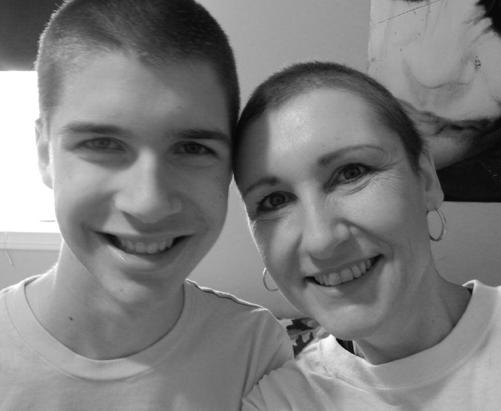100 Perks of Having Cancer: Plus 100 Health Tips for Surviving It (72 page)
Read 100 Perks of Having Cancer: Plus 100 Health Tips for Surviving It Online
Authors: Florence Strang
Tags: #Health; Fitness & Dieting, #Diseases & Physical Ailments, #Internal Medicine, #Oncology, #Cancer, #Medicine & Health Sciences, #Clinical, #Medical Books, #Alternative Medicine, #Medicine

to burn, I suppose you could fill your hot tub with Perrier.
Perk #72: Cancer Made Me Reevaluate the Relationships in My Life
301
Artesian Water
Water that flows from an underground source under its own power to the
surface. Picture a “water volcano” of sorts.
Source:
There are many sources around the world. Although “artesian”
sounds very exotic, it just means “coming from underground.” Any water
well that flows on its own without pumping, whether it’s in Fiji or in your
backyard, is also considered “artesian.”
Cost:
Approximately $2.20/16 ounces or $17.90/gallon.
Contains:
Various minerals totaling less than 250ppm including silica, flu-
oride, and bicarbonate, among others. Check the manufacturer’s site for
specifics.
Well Water
Same as artesian, only you have to drill for it and pump it out. Where I live,
and in many other places, well water is consumed regularly from a personal
well that is accessed on the owner’s property. There are a few companies
that bottle their waters from wells.
Source:
Well water is from an aquifer or water trapped hundreds of feet
below the surface in the bedrock (not just from digging a hole down in the
dirt like in a wishing well). There is no danger of groundwater runoff from
fertilizers or other chemicals from true well water. Well water should be
tested for bacteria and nitrates and other possible human health hazards
regularly, but because the water source is millions of years old, once a year
is usually sufficient for testing as that water doesn’t flow and change like
other water sources do.
Cost:
Drilling a well and having a pump installed is costly, but once in
place, all the water is free. There are some bottlers who sell well water and
will label it “spring” water, because it technically may come from an under-
ground spring, but it was obtained by drilling a well. Costs range from $1.00
to $2.10/16 ounces or $8.00 to $16.80/gallon.
302
100 Perks of Having Cancer
Contains:
Well water contains whatever is contained in the spring that was
tapped and is very similar to artesian water.
Vitamin-Type Water
This really has no business being called “water” at all. It really is a sweetened
man-made beverage. It sounds very healthy, doesn’t it? But I know you’re
smarter than that.
Source:
Processed, flavored product using any water source they choose.
Cost:
$1 to $4/16 ounces, depending on the brand. Some popular brands
are Vitaminwater, Powerade, Propel, Waddajuice, and SoBe Lifewater, among
others.
Contains:
Water, vitamins, coloring, sugar, or other natural sweeteners. It
can also contain preservatives and artificial sweeteners, herbs, and caffeine.
In July 2010, a judge ruled that one of the main brands of vitamin water
had to remove claims on their label that it is “healthy” as it contains 33
grams of sugar. (A can of cola has 39.9 grams.) It’s no big shock that the
major soda companies are the primary manufacturers of these “healthy
alternatives to sugary soft drinks.” Remember: vitamin-type water is neither.
Coconut Water
The newest member of the water family, coconut water has exploded onto
the stage, making claims that it is healthier and more effective than any
sports drink. In the last five years (2007–2012), the coconut water industry
went from $0 in sales to $35 million in sales.
Source:
From the young green coconut, this is the precursor to coconut
milk. While coconut milk is high in fat, coconut water is high in carbs and
minerals and is 95 percent “water.”
Cost:
$2 to $4 /11 ounces, $23 to $46/ gallon.
Contains:
Coconut water is very high in potassium and also has some
sodium and magnesium.
Perk #72: Cancer Made Me Reevaluate the Relationships in My Life
303
Despite the claims, testing indicated that coconut water does not rehy-
drate after exercise any better than plain water. It’s not harmful, but if you
read claims that it can cure cancer and prevent diabetes, that may be a bit
of an overstatement. While I’m a big fan of coconuts, in the end, coconut
water is just fruit juice without the fructose (sugar). Nutrition aside, if you
feel oh-so-trendsetting to be seen with your coconut water bottle, I say go
for it.
Beware of “coconut-
flavored
water,” which is H2O with natural or artificial
coconut flavor added. This kind of water never saw a coconut in its life.
The Number of Bottles That Are Made to Meet Americans’
Demands for Bottled Water
●
Requires more than 1.5 million barrels of oil annually, enough to fuel
some 100,000 U.S. cars for a year according to the Earth Policy Institute.
●
About 86% of plastic water bottles in the United States become garbage
or litter.
●
Plastic debris in the environment can take between 400 and 1,000 years
to degrade.
Our health depends on a healthy environment.
Bottom Line
Carbon-filtered tap water is the most economical and
easiest way to get your healthy drinking water,
Being healthy means
although some contaminants will still remain. If you
drinking lots of water. Be
are lucky enough to own a reverse osmosis system
informed about what kind of
(multilevel) in your home, you can filter out pretty
water you drink, and don’t
much everything that’s left. Think about where the
assume that because it has
bulk of your drinking water comes from, try to make
a sealed cap and high price
adjustments to improve the quality, and then see if
tag, that it’s good for you.
that fits into your healthy lifestyle.




Perk #73
Cancer Brought Out the
Family Resemblance to My Son
E
ver since the day Dono -
van was born, I’ve been
hearing the same thing over
and over again, “He looks
JUST like his father.” How-
ever, following my cancer
treatments, people started to
notice my resemblance to my
handsome son. Maybe it’s the
eyes? Could it be the nose?
No, it was definitely the hair!
While not all chemo drugs
cause hair loss, baldness is
the universal telltale sign that
a woman has cancer. Some
women are quite comfortable with their lack of locks. I met a brave woman
at the cancer clinic who told me that the only time she covers her head is
when it is cold outside. If people stare at her in a rude way, she will say
something like, “Excuse me, do I have a hair out of place?” That takes
courage. For some women, on the other hand, losing their hair is more emo-
tionally traumatic than losing a breast.
I fell somewhere in between those two extremes. I can honestly say that
I did not shed a tear when my hair fell out shortly after my first chemo ses-
sion. In fact, once it started coming out by the handful, I was like someone
with obsessive-compulsive disorder. As one woman put it, “It was like pluck-
ing a chicken. Once I started, I couldn’t stop.” While I’ve never had the pleas-
ure of plucking an actual chicken, I did give literal meaning to the
expression, “I feel like pulling my hair out!”
I 304 J


